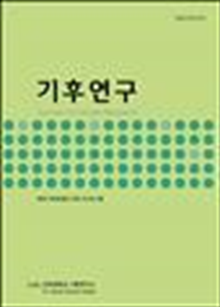간행물
기후연구 KCI 등재 Journal of Climate Research

- 발행기관 건국대학교 기후연구소
- 자료유형 학술지
- 간기 계간
- ISSN 1975-6151 (Print)2288-8772 (Online)
- 수록기간 2006 ~ 2021
- 주제분류 사회과학 > 지리학 사회과학 분류의 다른 간행물
- 십진분류KDC 453DDC 551
권호리스트/논문검색
제14권 제1호 (2019년 3월) 4건
1.
2019.03
서비스 종료(열람 제한)
This study aims to investigate the effects of climatic variability on the citrus yield in Jeju-do. This study analyzed the relationship between the citrus yield and climate elements(temperature, rainfall, sunshine duration etc) at each growing season. Temperature shows a positive relationship with the period of flower bud for the yield of citrus. The rainy days of bud bursting period have a negative relation in Seogwipo area. The sunshine duration of the 1st physiological fruit drop period was positively related to citrus yield in Jeju and Seogwipo area. The maximum temperature of the 2nd physiological fruit drop period and the fruit enlargement period were negatively related to the citrus yield. In Jeju and Seogwipo area, about 60% of the variation of citrus yield is explained by the variation of climatic factors. The sunshine duration of the 1st physiological fruit drop period and fruit enlargement period were selected to the yield estimation in Jeju. In Seogwipo, the number of rainy days and the sunshine duration of the 1st physiological fruit drop period were selected.
2.
2019.03
서비스 종료(열람 제한)
This paper investigates regime shifts in the wintertime Siberian High central intensity for the period from 1950 to 2017. One regime shift was found from a test for multiple regime shifts. A Markov switching model analysis identified the period of 1950-1987 as a strong intensity regime, 1988-2017 as a weak intensity regime, and 1987-1988 as the changepoint. We also found a regime shift in the wintertime temperature in Asia, which is consistent with that in the intensity of the anticyclone. The periods of 1950- 1986 and 1988-2017 are a low and high temperature regime, respectively, and the changepoint is 1986-1988.
3.
2019.03
서비스 종료(열람 제한)
We explored the transporting processes for the Asian dust observed over South Korea. The frequency of Asian dust days (ADDs) were used to analyze the associations of the ADDs with land surface conditions over the four source regions, including inner-Mongolia, the Gobi Desert, Manchuria, and Loess Plateau, and atmospheric synoptic variables over central and eastern Asia. Precipitation and Palmer Drought Severity Index (PDSI) in the source regions during the previous summer were negatively correlated with the ADDs in South Korea. Statistically and physically more significant processes were found in the associations of atmospheric synoptic conditions with the ADDs. The intensified winds of northwesterly-northerlynorthwesterly over a pathway of the Asian dust from the source regions to South Korea were identified during high ADDs years in South Korea. A dipole pattern of anti-cyclonic and cyclonic anomalies over central and eastern Asia, respectively, supported the Asian dust pathway.
자료
4.
2019.03
서비스 종료(열람 제한)
The climate-food relationship and effect of climate on staple grain crops have been studied widely. However, the relationship between climate and liquor and its characteristics are not explored sufficiently. This study presented the climate and its association with liquor over various climatic regions of mid-latitudes. There is huge diversity in vegetation and cultures due to various climates of the mid-latitudes and the manufacturing of liquor depends on the regional raw materials and methods.

